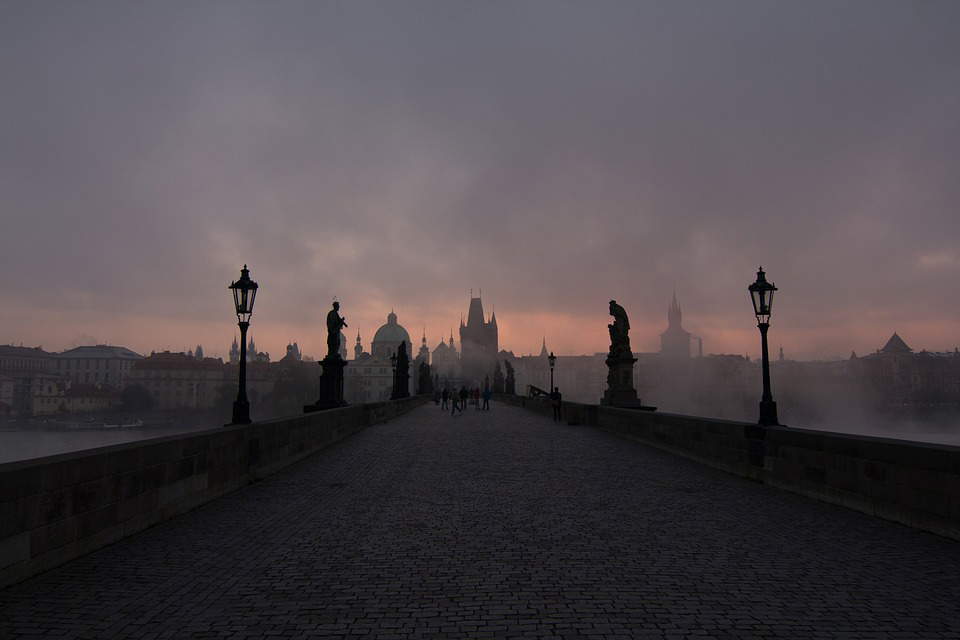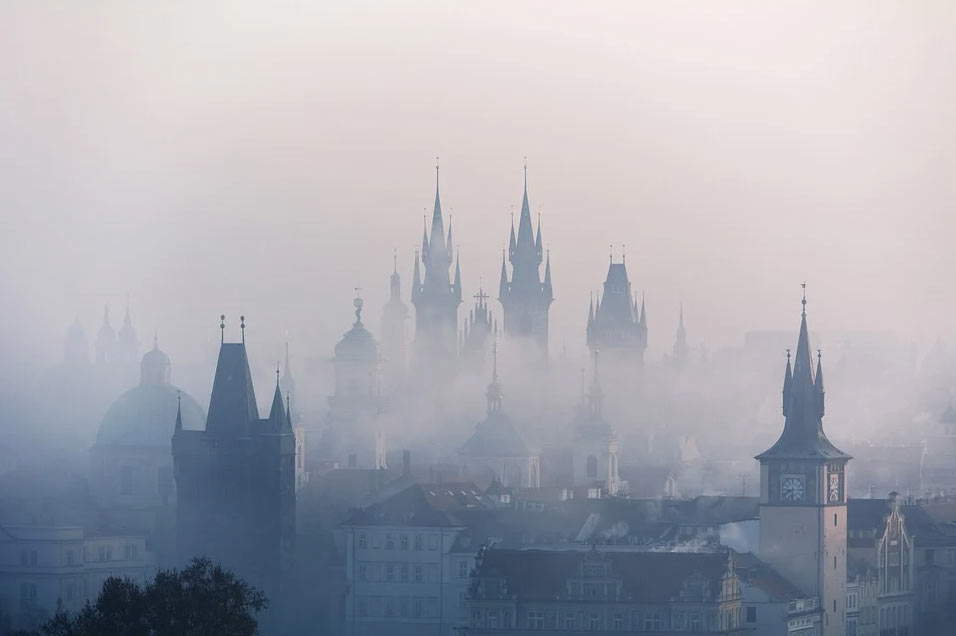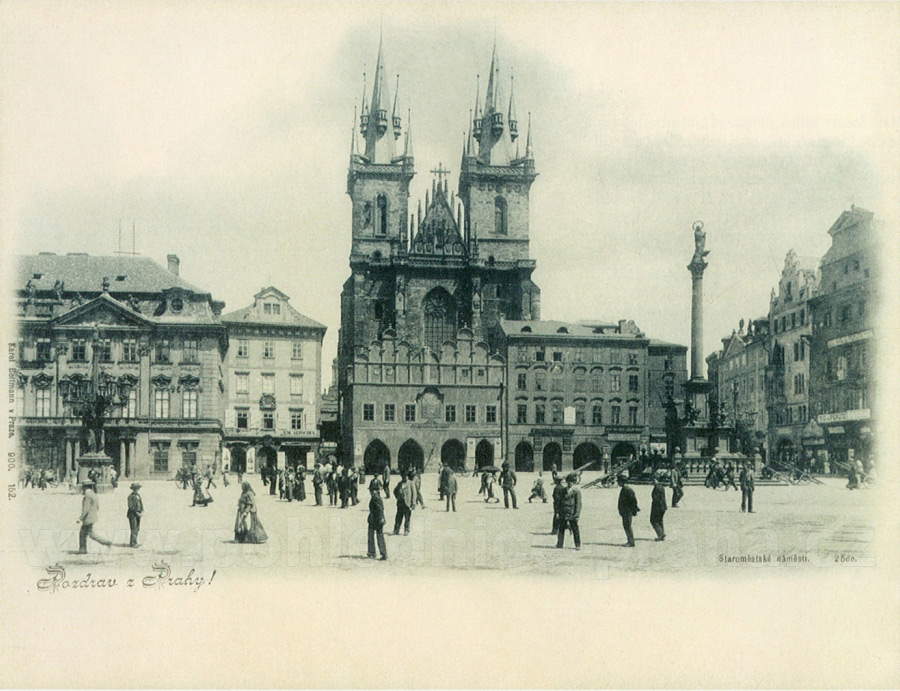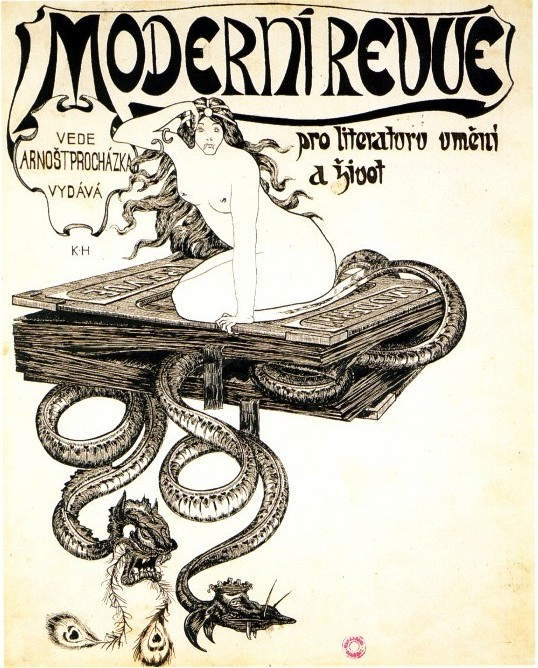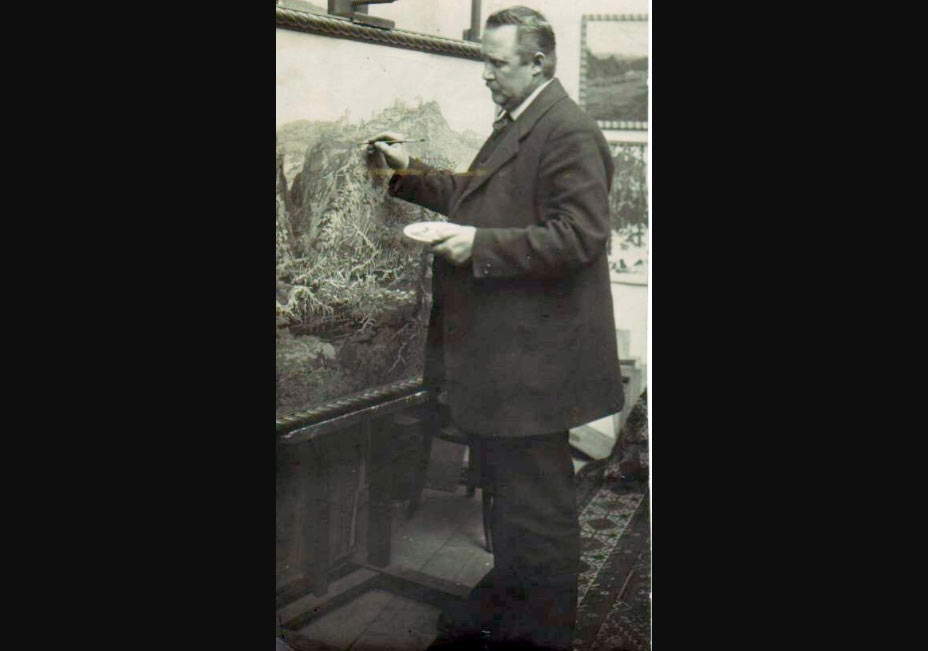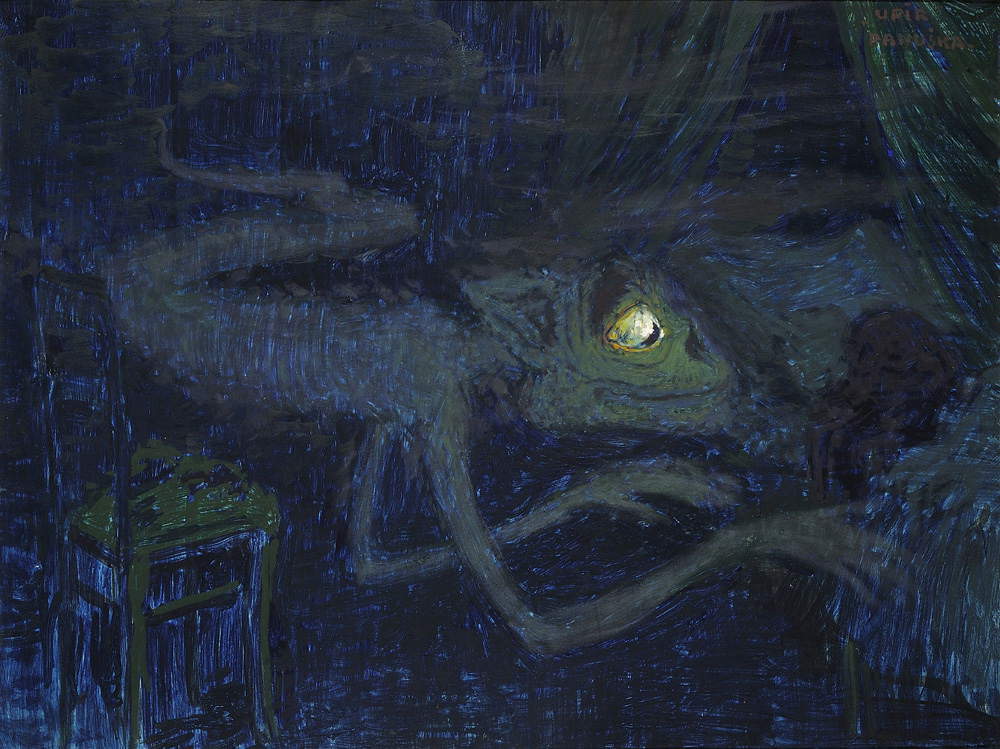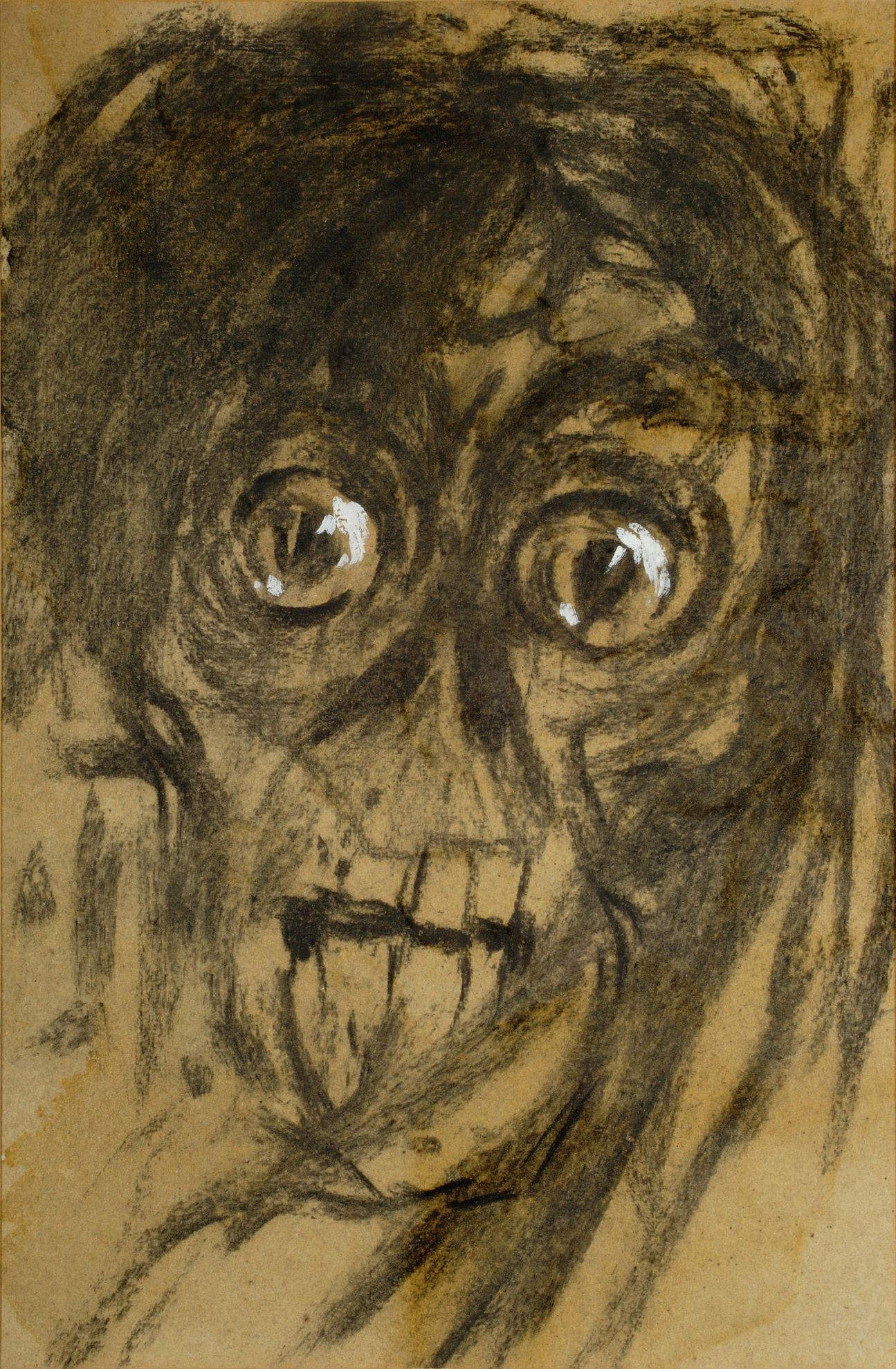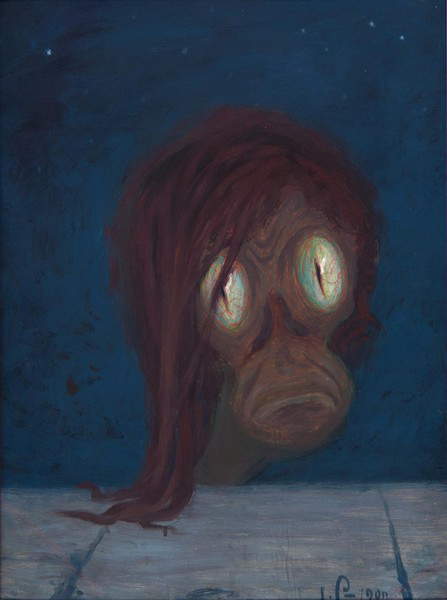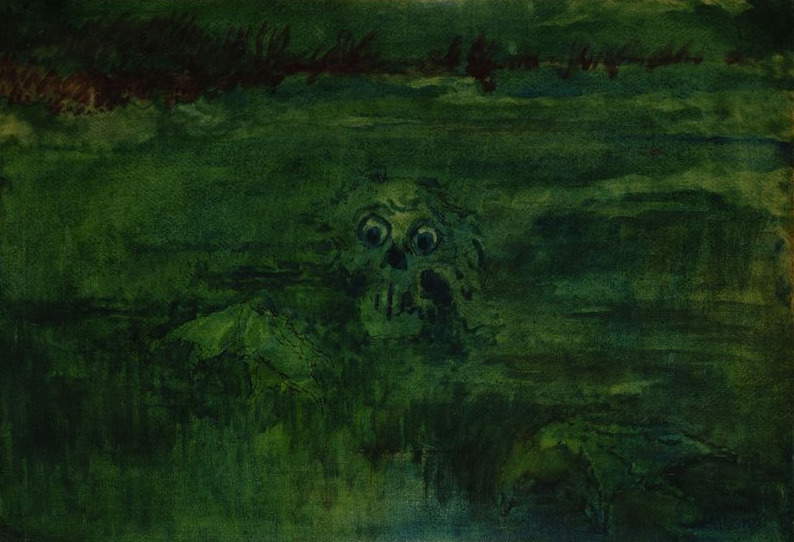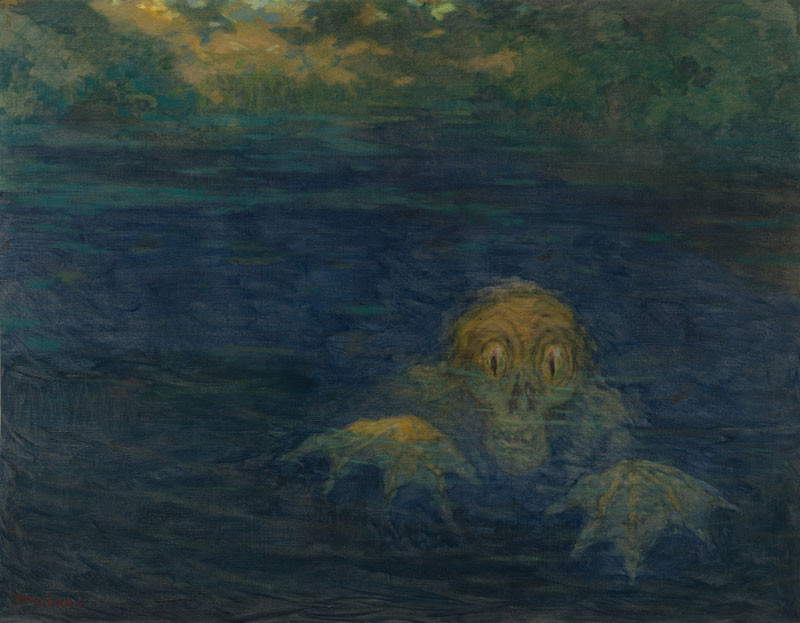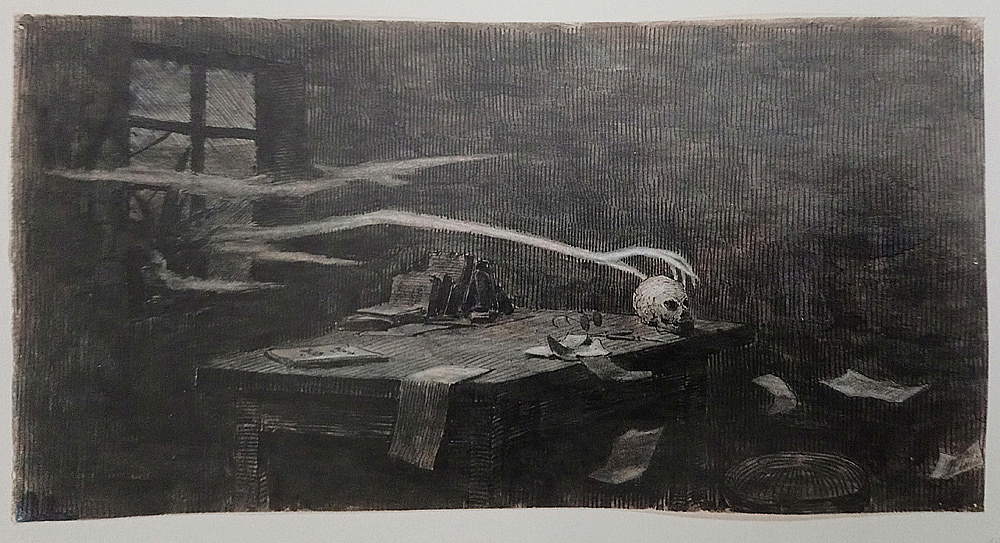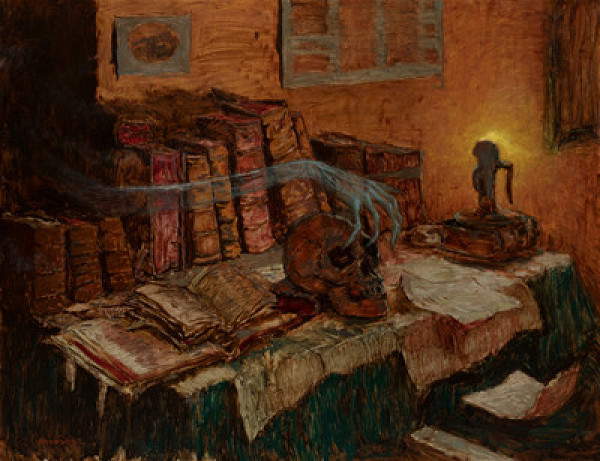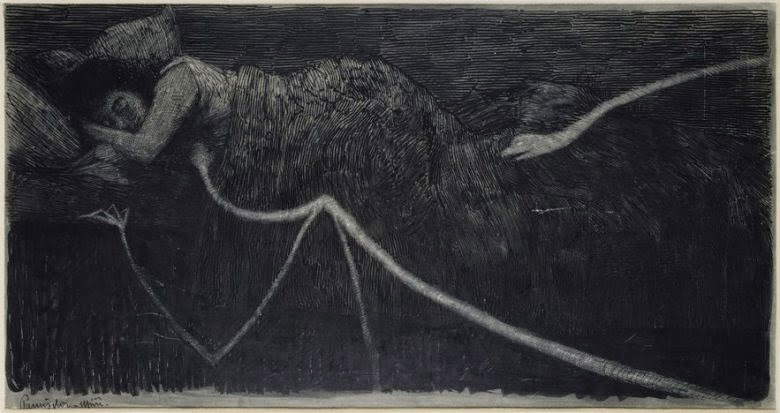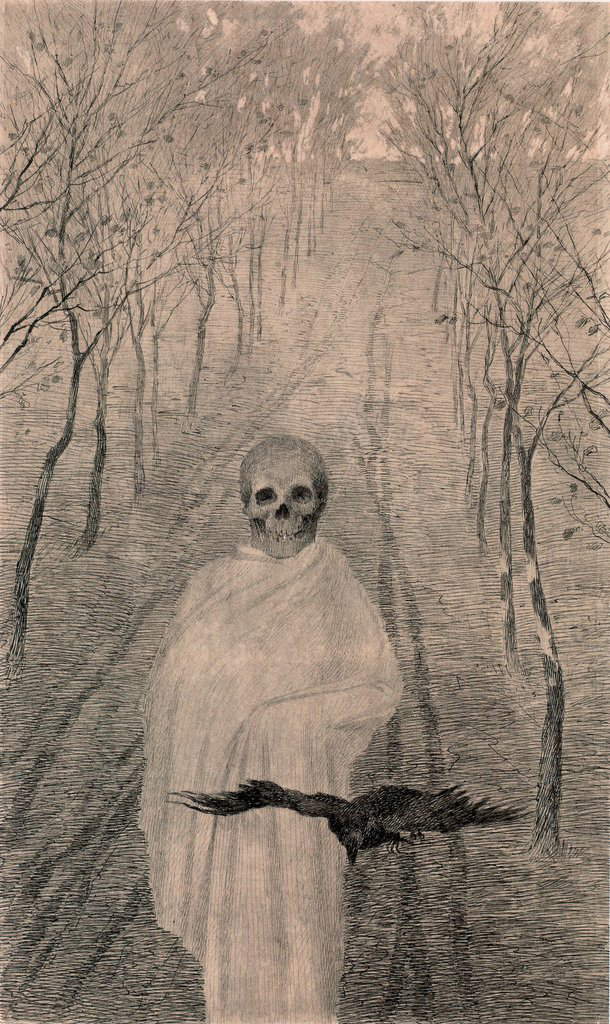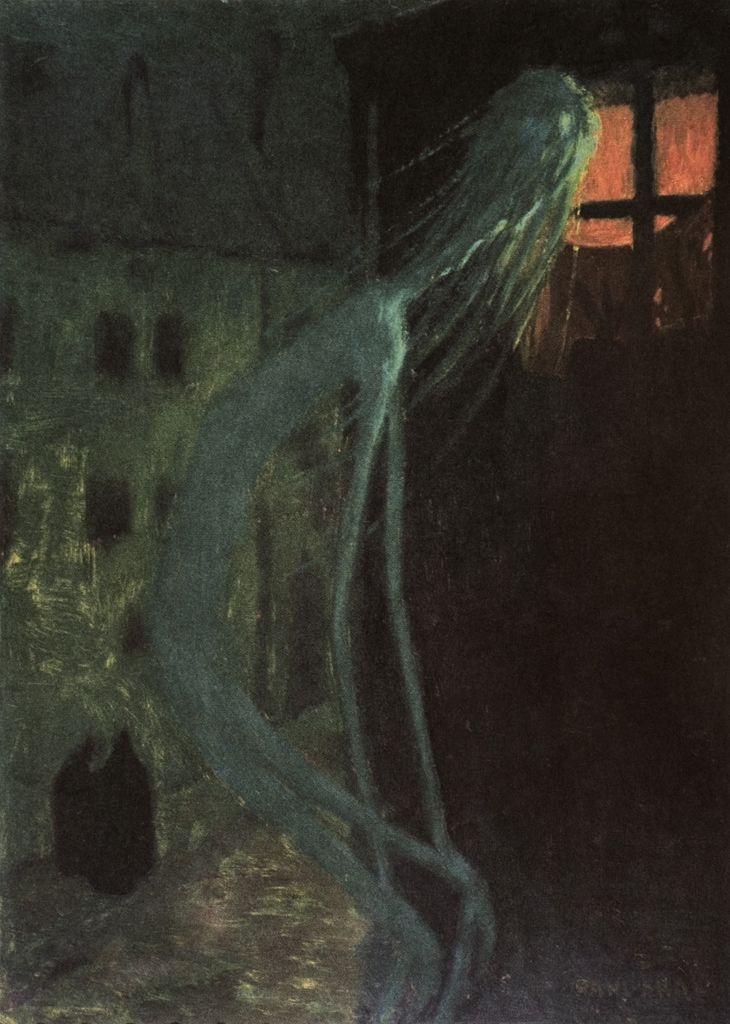by Federico Giannini, Ilaria Baratta , published on 31/10/2020
Categories: Works and artists
/ Disclaimer
Monsters, ghosts, spirits of the dead, restless presences: these are the protagonists of the works of Czech artist Jaroslav Panuška, who in the early twentieth century was the author of a vast, terrifying but little-known horror production.
In the late nineteenth century, in the intellectual circles of Bohemia, then part of the Austro-Hungarian Empire, there was a keen interest in the themes of mystery,horror, hermetic sciences, Christian mysticism and Eastern mysticism. Art historian Hana Larvová writes that “the sources of these new directions, which found an echo in the changes in the European artistic climate, are to be found in the aesthetics of Decadentism, already in vogue in the second half of the 1890s, which, affirming the need to let the creative individuality of the artist emerge, opened up to a wide range of themes that drew on areas hitherto considered taboo, ’horror, depravity, intricate nightmares and atrocious visions.’” Decadent aesthetics spread in Prague and Bohemia thanks to the intellectuals who gravitated around the journal Moderní Revue pro literaturu, umění a život (“Modern Review for Literature, Arts and Life”), published by a bank clerk, Arnošt Procházka, a publication that had the effect of inspiring the visual arts as well: the ramblings of writers, critics and poets such as Jiří Karásek ze Lvovic, Miloš Marten, Karel Hlaváček and others aroused in the artists, Larvová writes again, a keen interest “in the human unconscious, in pathological and irrational states of mind,” and a great “attraction to death and eroticism.”
Moderní Revue, founded in October 1894, had a monthly cadence and continued to publish for more than thirty years, ending its experience only with Procházka’s death: it was a disorganized project, lacking a defined cultural program, open to a wide congeries of different topics, welcoming contributions from personalities animated by even diametrically opposed visions of life and art (anarchists and right-wing extremists, Satanists and dandies, homosexuals and defenders of tradition). This feature caused considerable friction among the contributors but, against all odds, did not undermine the existence of the magazine, whose reins were held firmly by Procházka, although he may not have had a clear idea of the direction to take the publication (so much so that he did not even like to call himself decadent): he was simply interested in the publication being “modern.” Scholar Neil Stevens has written that the literary quality of the magazine was not even sublime, but nevertheless "Moderní Revue appears significant today [...] in that it acted as a platform for discussion and a medium for cultural exchange, a catalyst that encouraged the metabolism of the cultural system by absorbing foreign influences and stimulating critical digestion."
Thus, the role that Moderní Revue played in the cultural environment of Prague in the last years of the nineteenth and early twentieth centuries is undeniable. And the visual arts also found in the publication a continuous and constant source of inspiration, again seizing all the heterogeneous cues that the magazine could offer: Hana Larvová, in particular, identifies František Bílek ’s (Chýnov, 1872 - 1941) mysticism and Josef Váchal ’s (Milavče, 1884 - Studeňany, 1969) grotesque, witch-like devilry as the two positions at opposite extremes. Alongside these two figures who dominated the Czech arts scene of the early twentieth century were artists who were not equally fortunate but produced outstanding results: one of these was Jaroslav Panuška (Hořovice, 1872 - Kochánov, 1958). The son of a topographer, he arrived in Prague at a very young age, in 1889, to study at the local Academy of Fine Arts, where he was a pupil of Maxmilián Pirner and where he specialized mainly in illustration and the caricature genre, two areas destined to have a major impact on his later output.
 |
| Prague, the Charles Bridge |
 |
| View of Prague in the fog |
 |
| Staroměstské náměstí (Old Town Square) in a 1900 postcard published by the publisher Koppe-Bellmann |
 |
| Cover of an issue of Moderní Revue designed by Karel Hlaváček (1896) |
 |
| Jaroslav Panuška photographed in his studio in 1928 |
His career immediately began under the banner of horror and mystery art. As early as 1898, Panuška exhibited three of his drawings in a group show, receiving the appreciation of Hlaváček, who wrote in a review that his drawings “arouse unconscious feelings of terror and fear,” and of the artist said that “Panuška appears as a remarkable and original talent and as a true artist.” Panuška’s art, from the very beginning, was peopled with monsters, ghosts, vampires, demonic creatures, spectral apparitions, macabre allegories: these are subjects that the artist dealt with especially in the early part of his career (later he would develop a valid, though less well-known, career as a landscape painter, an area in which Panuška was highly appreciated), and a variety of reasons have been pointed out to explain why these constant presences occurred. Some are biographical: two events, in particular, marked Panuška as a boy, namely the vision of a hanged man, which deeply disturbed him, and above all the loss, in 1891, of his mother, who died during a stay in Bosnia after contracting typhus. Then there are his academic studies: at the time he was an Academy student in Prague, Panuška produced many satirical caricatures, and thus distortion of natural proportions and grotesque deformation were processes that the artist mastered with great confidence and made it easier for him to bring to life the monstrous creatures that lived in his paintings and drawings. Finally, personal interests: the echoes of the neuroscientific research of the physician Jean-Martin Charcot, who became director of the Salpêtrière hospital in Paris in 1862, and author of numerous studies on hysteria, related by Charcot himself to fixed ideas matured in the unconscious of the human being, had also reached Prague. Not only that: in Charcot’s school of neurologyhypnosis was also practiced and used as a method of treatment. In Bohemia it was especially the journal Svetožor that published articles on such topics as the care and treatment of the mentally ill, pathologies of the psyche, and the method of hypnosis itself.
And it is perhaps the fascination with hypnosis that gave rise to the paintings depicting vampires, the creatures we first find in Panuška’s art, partly due to the fact that the spread of the horror aesthetic led artists to recover the legends of Balkan folklore, and the vampire is the most well-known protagonist of these stories: however, it is not always the “vampire” as we are known to us from cinematic trivializations, that is, the undead who has perfect human features, except for his canines, and wanders in search of people whose blood he can suck. In some versions of the myth, particularly in Slavic folklore and also in Bohemian folklore, the vampire is the spirit of a person who has died a violent or unnatural death, takes on animalistic guises (it is often a reptile, mostly a lizard, characterized by one element that stands out above all others: huge eyes), and returns to the world of the living to torment them during the night. Scholar František Kaván reports that when Panuška was studying at the Prague Academy, a drawing of a vampire hung in a hallway that, according to one belief, hypnotized those who looked at it, and this episode could probably explain the constant presence of vampires in Panuška’s art. This is also because the artist does not place his spectres in defined narrative contexts: more often than not, his vampires and monsters simply stare at the viewer, or at least give him threatening glances, or do the same towards a character who appears in the painting (or outside the painting). This is so, for example, in one of his Phantoms preserved at the Západočeská Galerie in Plzeň, or in the Vampire in the Patrik Šimon collection. “An interpretative element of Panuška’s depictions of vampires and other monstrous beings,” says art historian Lucie Rychnová, “is precisely his intent to evoke in the viewer the horrors hidden deep in the human unconscious. For Panuška it was important not so much to illustrate concrete folk tales, but rather to provide his own commentary on the interest his contemporaries showed in extreme psychic states, psychoses, neuroses and the hidden, dark corners of the human soul. Acute psychic states that manifested themselves in hallucinations, visions and apparitions and in the spirit of the time became the foundation of legends and tales of fear, in which Panuška found inspiration.”
 |
| Jaroslav Panuška, Upir (“Vampire”) (c. 1900; oil on cardboard, 58 x 64 cm; Prague, Patrik Šimons Collection) |
 |
| Jaroslav Panuška, Strašidlo (“Ghost”) (1899; charcoal and white lead on paper, 345 x 225 mm; Plzeň, Západočeská Galerie) |
 |
| Jaroslav Panuška, Upir (“Vampire”) (ca. 1900; oil on cardboard, 50 x 63 cm; Private collection) |
 |
| Jaroslav Panuška, Strašidlo (“Ghost”) (c. 1900; oil on cardboard, 62.5 x 48 cm; Private Collection) |
The interest in the unconscious also explains the constant presence in Panuška’s work of the figure of the Vodník, a legendary creature typical of Bohemian folklore: it is a water monster that lives in the waters of the Vltava River in Prague and takes on different connotations in the different legends about it (so sometimes it is a positive and wise creature, other times it is instead an evil monster that lures its victims near the river to drown them). He is often described as an amphibian-like being, and it is in these guises that Panuška represents the Vodník in his works. He is essentially a creature that lives between two worlds, the world of humans and the underwater world, and the world of water, with its secrets and realities hidden deep within, is related to the anxieties of the human unconscious, which is probably why Panuška prefers to paint his Vodník as a monstrous creature, a predator lurking at the water’s surface, as in the painting at the Vysočiny gallery in Jihlava.
However, Panuška’s monstrous painting aims not only to disturb the viewer’s soul, but also to stimulate sensory experiences, as scholar Martina Schneiderová noted in her doctoral thesis dedicated to the artist. Placing himself in the wake of the synaesthetic researches that fascinated many artists throughout Europe in the late 19th century, Panuška often sought to create works designed to evoke a precise sensation by acting on the sense of touch, the one most important to the Czech artist. In his paintings there is often a long, skeletal hand touching someone or something, a claw grazing, or an object or person being lapped by a cold breeze. One feels chills observing, for example, the Nocturne also from the Patrik Šimon collection in Prague, which explores the theme of spirits returning from beyond the grave, fundamental to Panuška’s poetics. In this nocturnal haze, a draft of cold air enters like a puff of smoke from a window to take the form of a long, cadaverous hand brushing against a skull resting on a table, fluttering some papers that were stored there. That of the mist entering a window and turning into a ghostly hand is a motif that returns often in Panuška’s art, sometimes with interesting variations: for example, in a painting in the National Gallery in Prague depicting the visitation of the dead in a dwelling, the hand flickers the dim light of a candle, or sometimes we no longer see a hand, but the face of a deceased person blowing on the candle to extinguish it. The patches of mist that turn into spirits with long hands even reach out to touch sleeping women, as happens in the drawing Vampires.
 |
| Jaroslav Panuška, Vodník (1902; tempera on paper, 50 x 66 cm; Jihlava, Oblastní galerie Vysočiny) |
 |
| Jaroslav Panuška, Vodník (1896; oil on canvas, 119 x 152 cm; Prague, Národní Galerie) |
 |
| Jaroslav Panuška, Nokturno (1897; ink on paper, 15 x 300 mm; Prague, Patrik Šimon’s Collection) |
 |
| Jaroslav Panuška, Návštěva mrtvého (“Visit of the Dead”) (1897; oil on canvas, 95.5 x 125 cm; Prague, Národní Galerie) |
 |
| Jaroslav Panuška, Upiři (Vampires) (c. 1900; pencil on paper, 240 x 550 mm; Private collection) |
 |
| Jaroslav Panuška, Upiři (Vampires) (c. 1900; pencil on paper, 240 x 550 mm; Private Collection) |
It was said that the theme of spirits coming from beyond the grave is central to Panuška’s monstrous production: in a drawing in the National Gallery in Prague it is death itself that manifests itself, accompanied by a raven, in a ghostly driveway, but much more often it is the souls of the deceased that return to earth, as is the case in an oil on cardboard from the Východočeská galerie in Pardubice, where the protagonist is a ghost wandering through a cemetery, and as is the case in one of his most famous works, The Spirit of the Dead Mother, also replicated with several variations, and preserved like the previous one in Pardubice. A painting conditioned, as we have seen, by the personal experience of the artist, who lost his mother when he was still a boy. Here, the mother (not necessarily Panuška’s) is a restless soul who returns among the living in the guise of a skeletal spirit of enormous proportions who, as is the case with almost all the shadows seen in the Czech artist’s works, seems almost to arise from a cold mist that takes on human form. We imagine the ghost of her mother moving with slow, dragging steps through the streets of her city and then stopping in front of a house, the one she lived in when she was alive, with the lights still on on a gloomy night, to look through the window at what is happening inside. The spirit of her mother, Lucie Rychnová observes, “is not portrayed here as a positive occult force, but as a terrifying specter that, finding no peace, reappears in the world of the living.” According to Rychnová, the mother’s spirit “is a harbinger of death, since Panuška was familiar with folk tales about deceased mothers who, after death, return to their newborns.”
There is, in this work, all the best of this type of Panuška’s production: the shivers that the painting is able to procure by evoking tactile sensations, the gloomy and gloomy atmosphere, the disquiet that the frightening presence provokes in the same relative, the interest in the literary, philosophical and scientific subjects that were discussed with heated passion in early 20th century Prague. All of this combined with the despair felt by Panuška over a personal event that had upset him: and read in these terms, the painting also takes on a particularly poignant connotation.
 |
| Jaroslav Panuška, Smrt v aleji (Death in the Alley) (1900; pencil on paper, 410 x 250 mm; Prague, Národní Galerie) |
 |
| Jaroslav Panuška, Duch na hřbitově (Spirit in the Cemetery) (1900; oil on cardboard, 50 x 66 cm; Pardubyce, Východočeská galerie v Pardubicích) |
 |
| Jaroslav Panuška, Duch mrtvé matky (The Spirit of the Dead Mother) (ca. 1900; oil on cardboard, 68 x 48 cm; Pardubyce, Východočeská galerie v Pardubicích) |
 |
| Jaroslav Panuška, Smrtka nahlížející do okna umírajícího (“The Grim Reaper Looks in the Window of a Dying Man”) (1900; watercolor on paper, 460 x 350 mm; Prague, Národní Galerie) |
Jaroslav Panuška still remains a little-known artist outside the borders of the Czech Republic, for several reasons, beginning with the fact that his art never reached an international dimension, not to mention the fact that the artist worked mainly for local private patrons, and much of his work can still be found in private collections. And the study of his production is also a very recent affair, since the first and, until 2009, only reconnaissance of Panuška’s work was the anthological exhibition held at the Východočeská galerie in Pardubice in 1978. More recent contributions, on the other hand, are Martina Schneiderová’s aforementioned 2009 thesis and, above all, the extensive monograph compiled in 2016 by Jaroslav Valečka, at the moment the most extensive and up-to-date repertoire for getting to know Panuška’s production. It certainly does not help their dissemination that all the publications just mentioned are in Czech: as a result, outside the borders of the Czech Republic, Panuška has to content himself with a few appearances in catalogs of exhibitions to which his paintings have been lent, most recently the exhibition Art and Magic held in Rovigo between 2018 and 2019, and which featured three of Panuška’s works (the Vampire and Nocturne from the Šimon Collection, and The Spirit of the Dead Mother).
Despite being little known, Panuška’s is nevertheless a figure of definite interest: few other artists knew how to bring to life such horrific phantasmagoria as his. He was not, moreover, an artist fully ascribable to decadentism, nor was he a particularly tormented artist: marked certainly by certain experiences, but described by his contemporaries as a sociable, companionable artist. And able to carve out for himself later, as mentioned, a successful career as a landscape painter, often a far cry from that of his “horror” beginnings. But in the esoteric Prague, the mysterious Prague, the Prague of the occult, Jaroslav Panuška, the painter of ghosts and monsters, was among the artists who best translated into images the interests, fears and anxieties that enveloped Europe at the beginning of the short century.
Essential Bibliography
Francesco Parisi (ed.), Art and Magic. The Fascination of Esotericism in Europe, exhibition catalog (Rovigo, Palazzo Roverella, September 29, 2018 to January 27, 2019, Silvana Editoriale, 2018 Jaroslav Valečka, Jaroslav Panuška 1872-1958: pr&ucaron;vodce životem a dílem (“Jaroslav Panuška 1872-1958: a guide to life and works”), Paper Jam, 2016Martina Schneiderová and Markéta Odehnalová (eds.), Jaroslav Panuška. 1872 - 1958, exhibition catalog (Havlíčuv Brod, Galerii výtvarného umění, December 14, 2012 to February 3, 2013), 2012Martina Schneiderová, Jaroslav Panuška (1872-1958). Od pohádky k v?d? (“Jaroslav Panuška 1872-1958. From Fairy Tale to Science”), doctoral dissertation, 2009Grace Brockington (ed.), Internationalism and the Arts in Britain and Europe at the Fin de Siècle, Peter Lang Pub, 2009František Kaván, Přesýpání nalad. Básně e eseje z konce století ("Conveyance of Moods. Poems and Essays from the End of the Century), Prostor, 1989
Warning: the translation into English of the original Italian article was created using automatic tools.
We undertake to review all articles, but we do not guarantee the total absence of inaccuracies in the translation due to the program. You can
find the original by clicking on the ITA button. If you find any mistake,please contact us.
